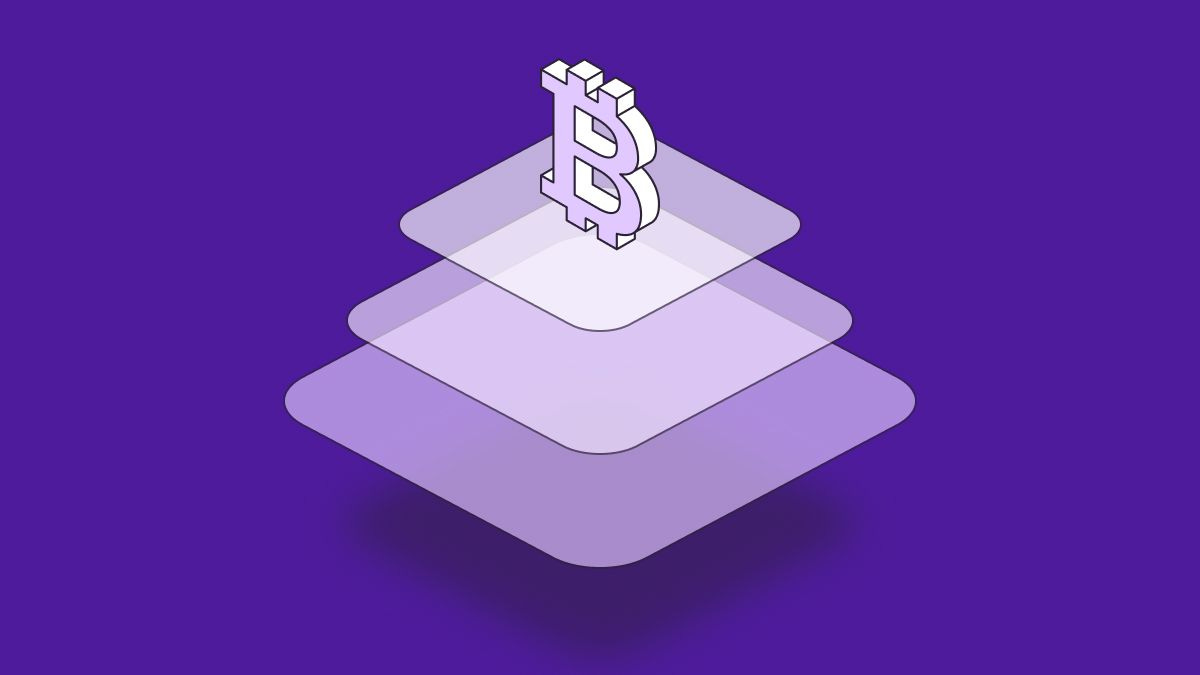The Layers That Scale Bitcoin
Bitcoin As A Store Of Value
A common critique of Bitcoin from crypto enthusiasts (as opposed to “Bitcoiners”) is that Bitcoin is slow and not very versatile. Yes, Bitcoin’s blocks are small and the time between block creation is long relative to other blockchains. “Bitcoiners”, however, would argue that these are features, not bugs.
Bitcoin is built to maximize decentralization, security, and predictability. Bitcoin’s small blocks are what enable actual decentralization of the network because anyone can run a full node and verify transactions on the blockchain. Bitcoin’s relatively long, average block time of 10 minutes supports the small blocks and increases the cost of a sustained 51% attack. The protocol itself is also slow to change and thus far, backwards compatible. The simple, slow moving nature of Bitcoin gives it predictability long into the future.
How Will Bitcoin Compete With Faster, More Versatile Blockchains?
The first answer is that it doesn’t need to. Bitcoin has emerged as a potential long-term store of value, and something that is a long-term store of value does not need to be quick or flashy. It needs to be steady, reliable, and better than existing alternatives. Looking at its features, Bitcoin is theoretically a better store of value than other assets. It is more inflation resistant, more easily verifiable, more easily transferable, more divisible, and less susceptible to theft than traditional stores of value such as gold, silver, bonds, fiat currencies, or real estate.
Bitcoin is also faster and more versatile than these traditional stores of value, but these features don’t make for a much better store of value, so it doesn’t really matter if other blockchains optimize for these features because they don’t provide a large improvement in the store of value domain. The only thing Bitcoin doesn’t have, compared to traditional stores of value, is a long track record. Critics argue that with Bitcoin down 70% from recent all-time highs, it doesn’t currently feel like a store of value. That’s a valid sentiment, however, in Bitcoin’s 13 years history, its purchasing power has never declined after any four-year period. To truly achieve its store of value claim, Bitcoin just needs to keep doing what it has been doing into the future.
The second answer to the question of how Bitcoin competes with faster and more versatile blockchains is that it can compete by scaling via additional layers. These layers, beyond layer 1, are means of interacting with Bitcoin beyond blockchain transactions.
Just like every time we interact with the US Dollar, we are not actually moving physical dollars around; there are instances when people interact with Bitcoin without performing an on-chain transaction. These additional levels of interactions are called layers.
The Layers Of Bitcoin
Layer 1
The first layer of Bitcoin is the actual Bitcoin blockchain. This layer is the distributed ledger of all past transactions since the genesis block. Based on the block size and block time, the network has an approximate capacity of 5-7 transactions per second or about 500,000 transactions per day. On a global scale, this is slow-moving, but as discussed before, it is the reliable, final-settlement layer of Bitcoin.
As a comparison, the first layer of the US Dollar would be the actual paper dollars and coins that people exchange. They require individuals to be in the same place, at the same time, and to possess the exact amount of currency needed to exchange. The final settlement of cash and of Bitcoin layer 1 transactions are what make these “bearer assets”. Exchange of Bitcoin and cash are final, and whoever possesses the asset owns the asset.
Layer 2
The additional layers are more of a framework of thinking about the application of Bitcoin, and the definitions are less clearly defined than layer 1. However, the definitions below are gaining in popularity.
The second layer of Bitcoin utilizes the first layer of Bitcoin in an open source and non-custodial way. The most popular layer 2 solution is the Bitcoin Lightning Network. This layer allows individuals to open channels between each other and permits Bitcoin to flow between the channels in a permissionless way without utilizing space on the Bitcoin blockchain every time value is exchanged.
In English, what does that look like?
Again, a US Dollar comparison is helpful. Imagine you want to go to a local cash bar, but imagine that the bartender doesn’t know you and doesn’t want to give you the beer without having payment from you. You could solve this problem by putting a hundred dollars in a lock box, attached to the bar. Then you could run up a tab, in a trustless manner. This verified tab is roughly the equivalent of opening a Lightning channel. On the Lightning Network, you open a channel with someone on the Bitcoin blockchain, layer 1, and you deposit Bitcoin into the channel. The Bitcoin on your side of the channel is still yours, but you can send the Bitcoin over to the other party, and wait until later to “settle up” with a second transaction on the Bitcoin blockchain. The transactions to open and close channels still occur on the Bitcoin blockchain with roughly 10 minutes between blocks, but the transactions between channels are nearly instantaneous.
The Lightning Network is superior to the bar tab because once channels are open, you are able to utilize any of the open channels to conduct transactions. At risk of stretching the analogy too far, imagine you go to the bar with a bunch of friends, but before you go, you set up a bunch of tabs with all your friends. Only one of you needs to open up a tab with the bartender, because you can just keep track of all the transactions and settle up later. When a friend orders a drink, the friend transfers money to you on the tab you have open with the friend, and you transfer money over on the tab you have open with the bar. Even better than this, with the Lightning Network, you can open channels with strangers and use any number of channel connections to conduct transactions in a trustless manner. Furthermore, the process of keeping track of the tabs is effortless for the intermediate parties.
This second layer does not have a cap on its capacity or transaction throughput. As the Lightning network gains adoption, the network effects make transactions even easier and make it more likely that a payment path through open channels will be found. This layer 2 is theoretically as fast or faster than Visa, Mastercard, or any other blockchain.
There are, however, some limitations to the Lightning Network, especially for new users without much liquidity. Channels take time to setup. To send Bitcoin to someone, you must be connected via open channels and have sufficient liquidity to send Bitcoin through all those channels. For people who are not well connected or for large transactions this can be difficult.
Another way to think about the Lightning network is as a series of abacuses. When you establish a Lightning channel with someone, you create a digital abacus between you and them. All the Bitcoin, however, is on your side of the abacus. You are limited to sending only what Bitcoin you established on your side of the abacus. Between some parties and for some payments, sometimes a payment route with sufficient liquidity doesn’t exist. You can typically rebalance your own channels by sending Bitcoin out on one channel and in on another, but you can’t force other parties to create that liquidity for you on their channels if it doesn’t exist.
Big players rebalance their channels often to have the liquidity to support more transactions. As the Network grows, and as the value of Bitcoin grows, the chances of payments going through with a random third-party increase. In summary, the layer 2 Lightning provides the possibility for rapid, relatively trustless transactions, but is limited by the effort to set up channels and whether the liquidity exists on the correct sides of channels.
Layer 3
The third layer of Bitcoin are custodial solutions that permit eventual final possession of the Bitcoin. Setting up a Bitcoin wallet, securing a seed phrase and actually “taking possession” of Bitcoin is not tremendously difficult. The process does, however, require a time commitment, some research, some personal responsibility, and roughly 200 dollars of equipment.
While it is not recommended by Bitcoin Maximalists, some people prefer to trust others with the responsibility of possession of their Bitcoin to someone else. For these people, a layer 3 solution, in which someone else maintains possession of the Bitcoin makes sense. A company like Coinbase, Mt. Gox, Celsius, BlockFi, CashApp (Block), or Strike will maintain possession of the Bitcoin for an individual. All the individual has to do is setup an account, send them US Dollars, and tell the company they want it converted to Bitcoin.
What are the advantages of this layer? One advantage is that this takes less effort from the individuals who don’t want to go through the effort of self-custody.
Another advantage is that it enables other financial services such as lending or payments. BlockFi (for non-US residents) will take the Bitcoin from clients and lend it out to generate interest for themselves and clients. BlockFi needs possession of the Bitcoin in this 3rd layer for this to work. Other companies, such as Strike or CashApp, use layer 3 to excel at payments. Entities who have accounts with Strike or CashApp do not need to conduct layer 1 or layer 2 transactions to transmit Bitcoin to each other. Strike or CashApp just need to maintain one ledger to determine when one entity sends value to another entity within their platform. They can also enable better interaction with layer 2 when people want to transact off their platform. Rather than individuals setting up their own Lightning node, opening channels, and managing liquidity on their channels, these companies set up and maintain large Lightning Network nodes. This enables quick and easy payments, which are not possible without individuals setting up an extensive layer 2 solution themselves.
Earlier this year, Strike announced a partnership with Shopify, NCR, and Blackhawk to enable rapid transactions for merchants utilizing the Bitcoin network instead of traditional credit card rails. This innovation will allow individuals to choose to send fiat money or Bitcoin and will allow merchants to receive fiat or Bitcoin regardless of the other party’s choice. The sender and the receiver do not need to have the same currency or even know what currency the other party is using because third-parties can supply the liquidity for the conversion and the transactions are settled instantaneously on the Lightning Network. The transaction merely utilizes the Bitcoin layer 2 rails to guarantee final settlement in a cheap and efficient manner, instead of utilizing the costly credit card system. The innovative partnership, however, would not really bring about mass adoption of the technology unless companies made the process easier for individuals.
This is where layer 3 comes in. Layer 3 enables the easy, quick transactions for the masses. Unlike our US Dollar systems, however, in which a few companies maintain the entire market share of payments, this won’t happen with Bitcoin. Because Bitcoin is an open monetary network, individuals can always interact with the system utilizing layer 1 or layer 2 themselves, and layer 3 companies will always be susceptible to competition due to the open-source nature of the network.
* (Stick Figure Photos from Jack Maller’s Bitcoin 2022 Presentation)
Layer 2’s analogy to the fiat world was not very common. Arguably, though, the US Dollar layer 3 equivalent is the most common layer we interact with. If our definition of layer 3 is, “custodial solutions that permit eventual final possession” of the asset, all of our interaction with dollars, other than cold hard cash fall into this category.
Accounts with the Federal Reserve? These have a custodian, the US Government, who maintains the ledger.
Government Treasuries? These are just promises from the Government of future payment.
Individual Checking and Saving Accounts with Banks? The banks are the custodians. (Furthermore, these accounts are fractionally reserved, meaning the bank is not actually holding the physical dollars that individuals deposit.)
PayPal, Venmo and CashApp? These are custodians.
Checks & credit cards? These are promises to pay dollars in the future and are maintained by custodians who facilitate the transfer of value.
With this framework, we see why comparisons of Bitcoin to Visa transaction throughput are so disingenuous. The comparison is comparing a level 1 transmission of value to a level 3 transmission of value. One involves the final transfer of a bearer asset and the other involves a multi-month process with numerous counterparties.
The existance of a custodian or counterparty in both the fiat world and the crypto world create additional risk. When you rely on a custodian, you risk that they mismanage your dollars or crypto. They could lose it. In fact, when you give your dollars or crypto to a custodian, you no longer own the dollars or crypto: you merely own a dollar or crypto IOU. The IOU is only as good as the counterparty. In the fiat world, banks and financial institutions are often insured, so you can usually rely on the IOU.
This is not always the case. Banks are fractionally reserved and don’t carry the physical dollars to cover everyone’s deposits, so they are susceptible to bank runs. We saw this recently in the Ukraine when people could not access their money or limits were placed on withdrawals. Banks and credit card companies can also freeze people’s assets that they custody. We saw this recently with the truckers whose accounts were frozen by the Canadian government and Canadian banks. In the crypto world, the use of third-party custodians is just as, if not riskier than in the fiat world. The greatest historical example of this was the Mt. Gox exchange, from which people never got some of their crypto IOUs paid out. Recently, the lending platform Celsius froze the funds of all crypto depositors. There is talk that BlockFi may also be in danger of losing funds due to similar lending issues.
Using custodians and counterparties comes with risk, but the risk isn’t always bad. The US Dollar custodians are useful and facilitate the digital 21st century world we live in. The Bitcoin custodians offer promises of just as many uses, if not more.
Layer 4
The fourth layer of Bitcoin is the layer which gives the users exposure to Bitcoin’s price movement but does not allow for possession of the Bitcoin.
Examples of this include PayPal, Venmo, and Grayscale Bitcoin Trust (GBTC). (Note, PayPal and Venmo have stated that they want to enable final possession in the future.) These platforms are very similar to layer 3, but they have the distinction that you can never withdraw your Bitcoin. You can deposit US Dollars and somewhat track Bitcoin’s performance against the dollar, but you can never actually withdraw the Bitcoin. There are certain advantages to this. If an individual has a PayPal or Venmo account, gaining access to Bitcoin’s price movement is easy. If an individual has a standard retirement account, they can gain access to Bitcoin’s price movement in a tax advantaged way, by buying something like GBTC. The negative, of course, is that you can never actually take possession of the Bitcoin.
The analogy to the fiat world is again harder to find on this layer. One example would be a bet on the performance of the US Dollar that is settled in some other sort of currency.
Conclusion
The Bitcoin blockchain doesn’t need to be improved to continue its process of becoming a long-term store of value. Bitcoin can compete with fiat currencies and with other blockchains by utilizing scaling via layers. Interacting with Bitcoin at different layers is not necessarily good or bad, but the interactions do provide different benefits and risk profiles. These layers enable faster payments, generate yield, and make Bitcoin more accessible to the masses. The layers do, however, often come with counterparty risk. The proper comparison, when comparing Bitcoin to fiat solutions, is to compare capabilities at the same layer. We can see why Jack Dorsey chose to build his “Web 5” on the back of the Bitcoin Blockchain, and not some new token. Bitcoin’s reliable and slow changing base layer blockchain make it a great platform for building additional stable layers into the future.








